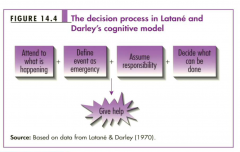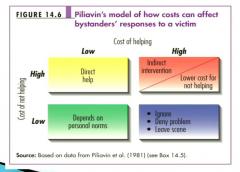![]()
![]()
![]()
Use LEFT and RIGHT arrow keys to navigate between flashcards;
Use UP and DOWN arrow keys to flip the card;
H to show hint;
A reads text to speech;
51 Cards in this Set
- Front
- Back
|
correspondent inference
|
causal attribution of behaviour to underlying disposition
Jones & Davis (1965) |
|
|
self discrepancy theory
|
the consequences of making actual - ideal or actual - ought self-comparisons --> revealing self-discrepancies
|
|
|
self-regulation
|
strategies we put in place to address mismatch between our (current/actual) behaviour to an ideal or ought standard
|
|
|
3 self-schemas
|
- actual
- ideal - ought according to Higgins (1987) self-discrepancy theory |
|
|
actor observer effect
|
- Nisbett & Jones
- extension of the correspondence bias - tendency to attribute OWN behaviour EXTERNALLY but OTHER's INTERNALLY |
|
|
correspondence bias
|
thinking that observable behaviour is caused by/is linked with (corresponds to) underlying personal attributions
|
|
|
false consensus effect
|
seeing own behaviour as more typical than it really it
(I like Neil Diamond - everybody must like Neil Daimond) |
|
|
self-serving bias
|
attributional distortion to protect/enhance one's self-concept/esteem
|
|
|
self-handicapping
|
publicly making 'excuses' (advanced external attributions) for future (feared) failure or poor performance
|
|
|
ULTIMATE attribution error
|
attributing
BAD OUTgroup behaviour INTERNALLY GOOD INgroup behaviour INTERNALLY and GOOD OUTgroup behaviour EXTERNALLY BAD INgroup behaviour EXTERNALLY |
|
|
covariation model
|
- Kelley
- cause of behaviour is assigned to the CO-VARIENT that fits most closely - Consistency / Distinctiveness / Consensus - high/low: all high = EXTERNAL attribution high + low + low = INTERNAL attribution |
|
|
primacy effect
|
according to Asch's Configural Model
- order of presentation effect whereby EARLIER presented info has disproportionate influence on social cognition |
|
|
recency effect
|
according to Asch's Configural Model
- order of presentation effect whereby LATER PRESENTED info has disproportionate influence on social cognition |
|
|
stereotype
|
SIMPLIFIED image of group member
|
|
|
prototype
|
TYPICAL/IDEAL image of group member
|
|
|
fuzzy sets
|
categories of features organised around a prototype
|
|
|
accentuation principle
|
similarities within group and
dissimilarities betw groups amplified if categorisation has subjective importance |
|
|
misattribution paradigm
|
according to Schachter's theory of emotional lability
(salt water/adrenaline injection experiment) - misattribution is attributing an event to something with which it really has no connection or association |
|
|
self perception theory
|
Bem
we gain knowledge about ourselves only by making self-attributions from observing our own behaviour |
|
|
disconfirmation bias
|
tendency to notice, refute or consider as weak any arguments that are contrary to prior beliefs
|
|
|
third-person effect
|
re persuasion
people's believe that they are less easily persuaded than others |
|
|
conformance
|
change in behaviour incl inward change of attitude
|
|
|
compliance
|
superficial, only outward/public change in behaviour without inward change of attitude
|
|
|
ingratiation
|
strategic attempt to get somebody to like you in order to obtain compliance
|
|
|
exemplification
|
strategic attempt to arouse guilt in somebody else in comparison to you as the 'morally respectable' person
|
|
|
supplication
|
eliciting pitty (by acting helpless, needy)
|
|
|
self-promotion
|
attempt to elicit respect by convincing other that you are competent
|
|
|
name 3 multiple request strategies
|
-foot in the door (small at first then big thing)
-door in the face (outrageously large first then smaller thing) -low balling (changing rule once agreement is reached) |
|
|
selective exposure hypothesis
|
people then to avoid potentially dissonant information (...I don't even what to hear about that ..)
|
|
|
self-affirmation theory
|
people reduce the impact of threat to self-concept by focusing on or affirming their COMPETENCE in OTHER AREAS
|
|
|
according to Higgins
discrepancy btw IDEAL and actual self causes ... |
... dejection
('d' in ideal & dejection) |
|
|
according to Higgins
discrepancy btw OUGHT and actual self causes ... |
... agitation
('g' in ought & agitation) |
|
|
task-oriented leader (task specialist)
according to Bales (1950) |
centrally involved, often offering opinions, gives direction
note: according to Bales, you can be only task or socio-emo focused, not both (opp. to Ohio State) |
|
|
socio-emotional leaders (socioemotional specialist)
according to Bales (1950) |
tends to respond and pay attention to the feelings of group members
note: according to Bales, you can be only task or socio-emo focused, not both (opp. to Ohio State) |
|
|
task-oriented leader
according to 'Ohio State leadership studies' |
high on initiating structure, defines the group's objectives, organised members, works towards goal attainment
note: different to Bales, Ohio State believes a person can score high on both dimensions (task & relationship) |
|
|
relationship-oriented leader (socio-emotional)
according to 'Ohio State leadership studies' |
high on consideration, concerned with welfare of subordinates, seeks to enhance harmonious group relationships
note: different to Bales, Ohio State believes a person can score high on both dimensions (task & relationship) |
|
|
what does a TASK focused leader
derive self-esteem from |
attainment of goals, task success
|
|
|
what does a SOCIO-EMO focused leader
derive self-esteem from |
harmonious group relations
|
|
|
situational control
|
according to Fiedler
how much control is required for effective task performance task structure + position power = situational power |
|
|
LPC
|
least preferred co-worker scale
(according to Fiedler's contingency theory) |
|
|
low LPC means what leadership style
|
authoritation
|
|
|
high LPC means what leadership style
|
democratic
|
|
|
bystander effect
|
Latané & Darley
people are less likely to help in an emergency when there are others around (number up, helping down) |
|
|
Describe the steps in the bystander effect
|

|
|
|
bystander-CALCULUS model
|
Piliavin
physiological arousal > labelling the arousal > evaluating the consequences |
|
|
empathy cost of not helping
|
Piliavin / bystander-calculus model
failing to help can cause bystander distress as they emphasise with victim |
|
|
personal cost of helping
|
Piliavin / bystander-calculus model
NOT helping may be costly (e.g. experiencing blame) |
|
|
how do costs effect bystander response
(according to Piliavin) |

|
|
|
four motives for helping others
(acc to Batson) |
- egoism (to benefit oneself)
- altruism (for the welfare of others) - collectivism (for family, ethnic group, country) - principlism (the greets good for the greatest number) |
|
|
according to the social MOBILITY belief system, social boundaries are ...
|
... permeable
|
|
|
according to the social CHANGE belief system, social boundaries are ...
|
.. IMpermeable
|

